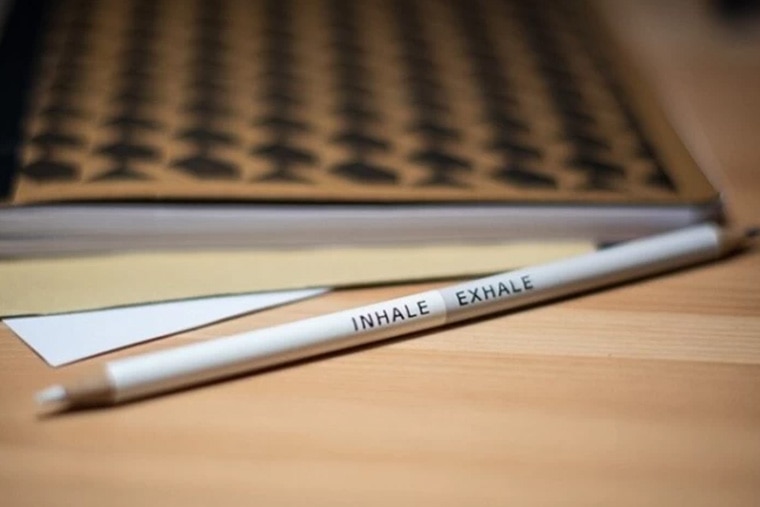There’s a treatment for migraine that is safe, has no side effects and may work as well as a preventive medication – but it’s not a pill. (3)
That treatment is biofeedback.
Biofeedback is a method of training people to control physiological functions, including heart rate, temperature, breathing rate and muscle tension. This is done using sensors that monitor these functions – e.g. a band around the chest to monitor respiration, electrical sensors on muscles to measure muscle contraction, sensors on the finger for temperature, heart rate and blood pulse volume.
Feedback from these sensors is used to track the effectiveness of various interventions that aim to change the body’s responses – increase the temperature of the fingers, for example, or lower the heart rate. Interventions focus on relaxation and calming the system and may include breathing exercises, visualisation, progressive muscle relaxation and meditation.
The goal of this training is to be able to use these interventions in everyday life to effectively reduce the impact of stress on the body, but without needing the sensors and monitoring equipment. It takes practice. Biofeedback training sessions are usually 30-60 minutes long and repeated 4-8 times, depending on how the training goes.
The evidence for effectiveness for migraine (and tension-type headache) is surprisingly high. Headache frequency can reduce by 35-45%, but biofeedback combined with medication can have an even greater effect. It can also reduce symptoms of anxiety and depression, increase pain tolerance and reduce the amount of acute medication needed, and the effects seem to persist for at least a year after the sessions are completed.
Of course, as with every treatment, this doesn’t work for everyone. But it’s a good option for people who haven’t responded to preventive medications, are experiencing significant stress, or are pregnant or wanting to become pregnant (when medications are often not advisable). It can also work for children and young people.
Biofeedback can be provided by a range of health professionals – physiotherapists, psychologists, occupational therapists – but they need to have the right equipment and training. It can also be expensive.
I had the opportunity to try it out at a discounted price with an occupational therapist who was learning to use the machinery. I don’t know if it reduced my headache frequency much, but it might have contributed to a reduced headache intensity. But I still think of it as one of the best things I’ve done to manage my migraine attacks.
I loved the sense of control that I gained from performing the breathing exercises. For the first time, this was a management strategy that I could actively participate in, not just passively take a pill or lie down with a wheat pack. And I could see how it worked. I have Raynaud’s syndrome, which is a condition in which the small blood vessels in the hands and feet constrict in response to cold or stress, leaving the fingers and toes numb and senseless. My fingers are very sensitive to cold, but with the breathing techniques, I could feel them warm and watch them become pink. I was astonished to find that a breathing rate of 5 breaths per minute was the optimal rate for me, the sweet spot where my heart rate dropped, my muscles loosened and I felt a quiet kind of equilibrium. At medical school, we’d been taught that 10-12 breaths per minute was ‘normal’ – clearly, the definition of ‘normal’ was up for review.
My positive experience was also due to the incredible empathy and kindness of the occupational therapist who worked with me, who was a better listener and counsellor than any psychologist I had attended. She took an holistic approach, getting me to talk about what else was going on in my life that was aggravating the migraine attacks. It was what I needed at the time.
Biofeedback might not be a magic bullet, but it’s another tool in the kit for dealing with migraine. I still do my 5 breaths per minute exercise every night as I wait for sleep to find me. A little more calmness in the system definitely can’t hurt.
Dr Fiona Imlach, Migraine Foundation Aotearoa New Zealand co-founder
Learn more
- Biofeedback and relaxation training for headaches, American Migraine Foundation
- What is biofeedback and should I try it? Migraine Canada
- Biofeedback therapy: How it works and benefits, Verywell Health
References
- Ailani, J, Burch, RC, Robbins, MS; the Board of Directors of the American Headache Society. The American Headache Society Consensus Statement: Update on integrating new migraine treatments into clinical practice. Headache. 2021; 61: 1021– 1039. https://doi.org/10.1111/head.1…
- Biofeedback in headache: an overview of approaches and evidence. Cleve Clin J Med. 2010;77(Suppl. 3):S72-S76.
- Diener H-C, Holle-Lee D, Nägel S, et al. Treatment of migraine attacks and prevention of migraine: Guidelines by the German Migraine and Headache Society and the German Society of Neurology. Clinical and Translational Neuroscience. January 2019. doi:10.1177/2514183X18823377
- Nestoriuc Y, Martin A, Rief W, Andrasik F. Biofeedback treatment for headache disorders: a comprehensive efficacy review. Appl Psychophysiol Biofeedback. 2008;33(3):125-140. 127.


